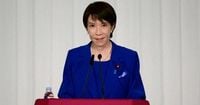Japan is poised to make history as Sanae Takaichi, a 64-year-old ultraconservative politician, appears set to become the country’s first female prime minister after a whirlwind of political maneuvering and coalition-building in Tokyo. The parliamentary vote, scheduled for October 21, 2025, will see Takaichi replace outgoing Prime Minister Shigeru Ishiba, capping a turbulent period that has left Japan’s government teetering on the edge of instability.
This dramatic turn comes after the centrist Komeito party abruptly ended its 26-year-long coalition with the Liberal Democratic Party (LDP) earlier in October. Komeito’s exit, prompted by concerns over slush fund scandals and Takaichi’s hardline positions, left the LDP scrambling for allies and with no clear path to maintaining power. According to AP, the Buddhist-backed Komeito cited the party’s “lax response to slush fund scandals” and unease with Takaichi’s “ultraconservative politics” as reasons for their split, which triggered a three-month political vacuum and intense wrangling within the government.
With the clock ticking and the risk of losing power looming, Takaichi struck a last-minute deal with the right-wing Japan Innovation Party (Ishin no Kai), led by Hirofumi Yoshimura. The coalition agreement, announced on October 20 and set to be signed at 6 p.m. local time, provides the LDP with Ishin’s crucial backing. “I told Takaichi that we should move forward together,” Yoshimura told reporters in Osaka, as reported by Reuters. The two parties’ combined 231 seats in the lower house fall just two short of a majority, meaning that while Takaichi is almost certain to win the vote for prime minister, her government will remain a minority and reliant on further opposition support to pass legislation.
The political drama has sent ripples through Japan’s markets and society. Investors, anticipating a government with an appetite for higher spending, sent the Nikkei share index soaring more than 2% on October 20, while the yen weakened. Fumika Shimizu, a strategist at Nomura Securities, told Reuters, “Expectations for Takaichi’s economic policies, which include fiscal expansion and monetary easing, appear to be facilitating rising share prices and a weaker yen.” However, Ishin’s small-government stance could temper some of Takaichi’s ambitions, setting the stage for policy clashes within the fragile coalition.
Takaichi’s rise is historic—Japan has long lagged behind other developed nations in gender equality, and her impending premiership breaks a glass ceiling in a country where women remain underrepresented in political leadership. Yet, the response among Japanese women has been muted, if not outright skeptical. Sociologist Chizuko Ueno posted on X, “The prospect of a first female prime minister doesn’t make me happy,” explaining that while Takaichi’s leadership might improve Japan’s gender equality ranking, “that doesn’t mean Japanese politics becomes kinder to women.” Political commentator Chiyako Sato, writing for the Mainichi newspaper, echoed this sentiment, saying, “Ms. Takaichi’s policies are extremely hawkish and I doubt she would consider policies to recognize diversity.”
Takaichi’s stances are firmly ultraconservative. She opposes same-sex marriage, a revision to the civil law that would allow married couples to keep separate last names, and supports male-only succession within the imperial family. As AP notes, the prospect for a dual surname system is fading under her leadership, a move that many see as a setback for women’s rights. Takaichi is also a vocal advocate for a stronger military, supporting a plan to double Japan’s defense budget to 2% of GDP by 2027. With U.S. President Donald Trump expected to push Japan to raise its defense spending to NATO’s 5% target and purchase more U.S. weapons, Takaichi faces immediate and complex diplomatic tests.
Her foreign policy positions are equally hardline. Takaichi, often described as a “China hawk,” has called for a revision of Japan’s pacifist postwar constitution to formally recognize the military’s role. She is a regular visitor to the controversial Yasukuni Shrine, which honors Japan’s war dead—including convicted war criminals—a gesture that has repeatedly angered China and South Korea. In an apparent effort to avoid further diplomatic fallout, Takaichi sent a religious ornament to the shrine on October 17, instead of visiting in person, according to AP.
Domestically, Takaichi faces a daunting agenda. She must quickly assemble a Cabinet and deliver a policy speech within days of taking office. Her economic policies are expected to emulate those of the late former Prime Minister Shinzo Abe, focusing on short-term measures to address rising prices, salary increases, and subsidies. However, critics argue that she lacks a long-term vision for tackling Japan’s demographic challenges, such as population decline, and has not shown openness to policies that would foster diversity or address the needs of a growing foreign population amid rising xenophobia.
Her election as LDP leader was orchestrated in part by Taro Aso, the 85-year-old conservative kingmaker and former prime minister. Takaichi promptly appointed Aso as party vice president and handed top positions to his allies, including those linked to the recent funds scandal. This move has raised eyebrows among political observers, who see it as a sign of entrenched power politics within the LDP.
Yet, the stability of Takaichi’s government is far from assured. The coalition with Ishin, while enough to secure her the premiership, leaves her vulnerable to shifting alliances and the need for ongoing negotiations with other opposition groups. Masato Kamikubo, a political science professor at Ritsumeikan University, described the situation as “pathetic,” telling AP, “There is no room for Takaichi to show her true colors. All she can do is cooperate per policy.”
Political experts predict that a Takaichi administration may be short-lived, with the possibility of an early election later in 2025 if the coalition cannot regain a majority in the lower house. The ideological gap between Takaichi’s fiscal expansionism and Ishin’s preference for spending cuts could further strain the alliance. “The era of LDP domination is over and we are entering the era of multiparty politics,” Sato told AP. “We need to find a Japanese way of forming a coalition and a stable government.”
The current political turbulence, observers say, mirrors broader trends in democracies worldwide, where mainstream parties are losing popularity and voters are increasingly motivated by anger and resentment. As Columbia University’s Gerald Curtis put it, “What’s going on here right now is what’s going on in all our democracies for a lot of complicated reasons.”
As Takaichi stands on the threshold of becoming Japan’s first female prime minister, the nation faces a new era of political uncertainty, ideological contest, and urgent diplomatic tests—an extraordinary moment that could redefine the country’s political landscape for years to come.


